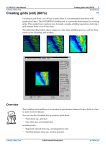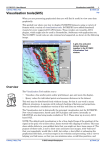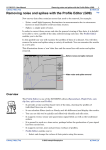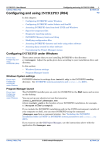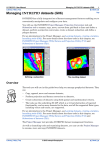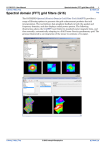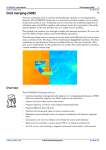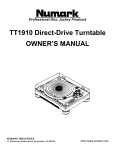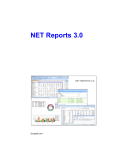Download INTREPID Guided Tours Introduction (G01)
Transcript
INTREPID User Manual Library | Help | Top INTREPID Guided Tours Introduction (G01) 1 | Back | INTREPID Guided Tours Introduction (G01) Top This book contains illustrated step by step instructions for a demonstration of basic INTREPID operations. The demonstration uses sample INTREPID data provided in the INTREPID installer. You can use the demonstration as a first step in evaluating INTREPID or as introductory training in its use. INTREPID is published by Intrepid Geophysics (formerly trading as Desmond Fitzgerald and Associates Pty Ltd). How to evaluate INTREPID We suggest the following process for evaluating INTREPID: • Obtain an evaluation license from Intrepid Geophysics (IG) or one of our agents. • Work through the Guided Tours to help you decide if INTREPID is suitable for processing your data. Contact IG or our agents for technical support if necessary. • Contact IG or one of our Agents for any information you need before evaluating INTREPID further. • Carry out a second level evaluation. IG provides resources to help you through this more detailed evaluation using your own data with an INTREPID evaluation licence. How to contact us For contact information, go to the Intrepid Geophysics website. World Wide Web: www.intrepid-geophysics.com Library | Help | Top © 2012 Intrepid Geophysics | Back | INTREPID User Manual Library | Help | Top INTREPID Guided Tours Introduction (G01) 2 | Back | Brief Description of INTREPID INTREPID is a geophysical processing and interpretation software package with the following features: • Library | Help | Top INTREPID can perform all stages of your geophysical data processing using a common database format and graphic user interface. Functionality includes: • Acquisition processing, • General processing • Interpretation. • INTREPID consists of a number of independent software modules. You are not obliged to purchase the entire package. • INTREPID operates under SOLARIS, LINUX, Windows, Mac OS X. • INTREPID has 64 bit versions for all operating systems • INTREPID uses innovative graphical and visual feedback techniques to support ease of use and rapid learning. • INTREPID uses a database to support and integrate all functions. This database • Has no systemic size limits (The size of a dataset is only limited by the resources of your computer); • Can be accessed seamlessly by all INTREPID tools. © 2012 Intrepid Geophysics | Back | INTREPID User Manual Library | Help | Top INTREPID Guided Tours Introduction (G01) 3 | Back | INTREPID System structure The diagram below shows the major components of INTREPID. Note especially that INTREPID tools: • Perform a complete range of geophysical processes, • Are fully integrated and • Can all access the same binary database. Import, Export Database Native INTREPID OR INTREPID-compatible format Line, point, polygon, grid data No systemic size limits Other data format Editing & Utilities Corrections & Processing Spreadsheet, Line Profile & Flight Path Editing Magnetic Gravity Projection Conversion Radiometrics Grid Merge Gridding Grid Operations Levelling Tie Line & Network Levelling Decorrugation Micro levelling Filtering FFT Grid Filtering Spatial Grid Filtering Line Filtering Gridding Interpretation & Modeling Visualisation & Map Composition Library | Help | Top Append, Subsection, Split Cruise Naudy Euler Visualisation Edge ` Detection Magnetic Map Composition Map Printing © 2012 Intrepid Geophysics | Back | INTREPID User Manual Library | Help | Top INTREPID Guided Tours Introduction (G01) 4 | Back | Guided tour pathways Depending on your interests and level of expertise, the Guided Tours have a number of pathways that you can follow. Basic magnetics pathway This sequence of Guided Tours demonstrates the basic processing sequence for magnetic data using INTREPID, from beginning (data import) to final (data export). To follow this pathway, complete the following tours: • Importing data to INTREPID (G03) • Introduction to the Spreadsheet Editor (G04) • Levelling—removing the GRF component (G12) • Levelling—tie line levelling (G13) • Levelling—decorrugation and microlevelling (G14) • Exporting data from INTREPID (G18) This series uses the Albury dataset. See The Albury dataset Sample datasets—installing, locating, naming The Ebagoola dataset Ebagoola is a magnetics dataset covering a region of Cape York Peninsula in Queensland, Australia (between 143°E 14°S and 143°30’E 14°30’S). For the exercises we provide a small portion of the Ebagoola dataset (ebagoola_S) which includes about 30 acquisition lines and two tie lines. The Albury dataset This dataset is a small section of data from Albury, Victoria. The data custodians are Geoscience Victoria, Department of Primary Industries, Melbourne, Australia. The data is freely available through the Geoscience Australia GDADS (Geophysical Data Archive Delivery System). Availability of sample data for exercises The sample data is automatically available in the CD-ROM version of INTREPID. We call the larger version of the download by this name for historic reasons. The advent of fast internet downloads, means that we can routinely expect a user to not be worried about a down load of 300MBytes or more. The web download version does not bundle the sample data. Installing or reinstalling sample data for exercises When you install INTREPID, use Custom Install to include this data. For Windows: if you installed INTREPID before and now want to install the sample data, either insert the CD-ROM, or double click on the MSI installer packkage and use Add or Remove Programs in the Control Panel to Change the installation and include the sample data. If you have changed the sample data and want a ‘factory reset’ of it, you can restore the original files: Library | Help | Top 1 Make a copy of any results that you want to keep 2 Insert the CD-ROM (if you have one) and use Add or Remove Programs in the © 2012 Intrepid Geophysics | Back | INTREPID User Manual Library | Help | Top INTREPID Guided Tours Introduction (G01) 5 | Back | Control Panel to Repair the installation. For LINUX, the installer is a simple jar file, that is functionaly similar to the MSI Location of sample data for Guided Tours We provide two complete sets of sample datasets, one in INTREPID format and one in Geosoft format. INTREPID works equally well with both formats. When you want to open a dataset, navigate to the directory containing the required data format. Where install_path is the path of your INTREPID installation, the project directories for the Guided Tours sample data are install_path\sample_data\guided_tours\intrepid_datasets and install_path\sample_data\guided_tours\geosoft_datasets. For example, if INTREPID is installed in C:\Program Files\Intrepid\Intrepid4.5.nnn, then you can find the INTREPID format sample data at C:\Program Files\Intrepid\Intrepid4.5.nnn\sample_data\ guided_tours\intrepid_datasets This is the default location for the sample data. If you have installed INTREPID normally, the data resides there. If you have installed INTREPID elsewhere, the exercises will work just as well. Just use the appropriate pathnames. For more information about installing the sample data, see "Sample datasets— installing, locating, naming" in INTREPID Guided Tours Introduction (G01) For a more detailed description of INTREPID datasets, see Introduction to the INTREPID database (G20). For even more detail, see INTREPID database, file and data structures (R05). Location of sample data for CookBooks Right next to the Guided tours data, is a rich set of more exotic geophysics datasets and grids, already prepared for the cookbook training sessions. A casual user might also gain some trial and error insights into the capbilities of the software, just by testing the Project Manger’s ability to preview and describe the attributes of each of the cookbook datasets. INTREPID file and dataset names Generally speaking, you can use any name that is acceptable to your operating system for INTREPID datasets but we recommend that you note the following: Library | Help | Top • We recommend that you do not use spaces in file, folder or vector dataset field names. Use ‘_’ instead. • INTREPID uses the '.' character for cetain purposes. We recommend that you don’t use it in file, folder or vector dataset field names. • INTREPID is file-compatible between UNIX and Windows. This means that you can create and process the same datasets with either version of INTREPID. There are some small issues to remember, however. • Windows and Mac OS are case insensitive but case preserving. For example if a dataset is called MyGrid.ers, it will always show as MyGrid.ers. However, if you type mygrid.ers when specifying the dataset, INTREPID locates MyGrid.ers for you. © 2012 Intrepid Geophysics | Back | INTREPID User Manual Library | Help | Top Library | Help | Top INTREPID Guided Tours Introduction (G01) 6 | Back | • Linux and Solaris are case sensitive and case preserving. This means that theoretically you could have two datasets existing side by side, one called MyGrid.ers and the other called mygrid.ers. • To minimise risk of confusion, it may be easier to avoid capital letters and spaces in file names. © 2012 Intrepid Geophysics | Back | INTREPID User Manual Library | Help | Top INTREPID Guided Tours Introduction (G01) 7 | Back | Solution datasets and file names In a set of guided tours like this we can’t assume that you will wish to exhaustively carry out every single step. For this reason we have provided solution datasets and files for every step of the process. You can choose whether to use the dataset or file you have created or the equivalent solution dataset or file provided as input for a subsequent step that requires it. We use a naming system for files and datasets you create during the guided tours and the corresponding solution datasets and files provided. The names of datasets and files you create are the same as the solution datasets or file names but with a 1 added. For example, if the guided tour specifies an output dataset called raw_grid1, then the solution dataset provided will be called raw_grid. You can use either dataset if required for input in a later process. Whenever you need to specify a previously created dataset or file for input, we recommend that you use the solution dataset provided rather than the one you create. This will help to streamline your first overview of INTREPID. You will have opportunities to verify that INTREPID works properly during later evaluation stages with your own data. Importing your own data into INTREPID datasets INTREPID can import a wide range of data formats into its database structure. INTREPID also offers direct support for a range of different formats, such as Geosoft line and grid datasets, relational databases such as Oracle and Postgress, ESRI shape files, MapInfo TAB files, and GMT, DODDS/DAPS grids. If INTREPID cannot import your data we will write a special import facility for you. INTREPID can also export data in a wide range of formats. If you are impressed with INTREPID after going through the Guided Tours and want to see more, please contact us. We will arrange an extended evaluation licence so that you can process your own data. Gradient, tensor and other advanced datasets INTREPID has many innovative tools that support vector, tensor and other advanced geophysical datasets in a coherent, simple and direct manner. It keeps the related channels together using tensor and observed vector data types. These features are available for you to test. Example vector, tensor line datasets as well as full tensor grids are available for training and testing. Contact our support service for assistance. Library | Help | Top © 2012 Intrepid Geophysics | Back | INTREPID User Manual Library | Help | Top INTREPID Guided Tours Introduction (G01) 8 | Back | Guided tour format Each guided tour contains a brief introduction, illustration of the main tool that it demonstrates and the following sections: Overview This section contains a list of the main features of the tools you will use and a brief introduction to the exercise you will carry out. Context of this guided tour This section explains where the exercise would fit into a ‘real life’ data processing cycle. Should you complete this guided tour? This section classifies the tour as introductory or advanced and states its relative importance to your understanding of INTREPID. What you will do This section contains a simple flowchart describing the guided tour. Steps to follow This section gives detailed illustrated steps for the exercise that you will carry out. Key points for this guided tour This section summarises the main points to note about the tools and processes demonstrated in this tour. Frequently asked questions This section contains the answers to questions that potential users may ask about the tools and processes demonstrated in this tour. Additional information Tip: ‘Tip’ text contains background information that will help your understanding of INTREPID but is not essential for completing the Guided Tour. Library | Help | Top © 2012 Intrepid Geophysics | Back | INTREPID User Manual Library | Help | Top INTREPID Guided Tours Introduction (G01) 9 | Back | Check points and short cuts in the Guided Tours case study These guided tours use a case study approach, where you process one set of data from the raw state to the final corrected and enhanced state. There are, of course, several stages in the process and in a real situation you would use the output from one process as the input for another. You may have limited time for completing these guided tours and may therefore wish to skip some steps and processes. These guided tours have a number of features to speed your progress: • • • • Library | Help | Top Solution datasets and files provided—You never need to have completed a previous process in order to perform one that is of interest; Optional steps in the tours. Tours often contain processes covered in detail by an earlier tour. You may not learn anything new by repeating the process, so we mark these steps as optional, using the symbol appearing to the left of this paragraph. If you omit an optional step you may need to use a solution dataset or file for some subsequent step. Steps where you compare data from before and after a process are also marked as optional; Should you complete this guided tour? Each chapter has a section with this heading, also indicated by the symbol shown at the left of this paragraph. The section gives advice about the relevance of the processes in the chapter to your interests; Task specification (job) files. You can use these to automatically set parameters for a process instead of using menus and dialog boxes. Instructions for using them appear below. We use the symbol shown to the left of this paragraph wherever you can use a job file; © 2012 Intrepid Geophysics | Back | INTREPID User Manual Library | Help | Top INTREPID Guided Tours Introduction (G01) 10 | Back | Task specification (job) file short cuts The INTREPID task specification file system allows you to preload an interactive tool with settings for a task. Task specification files are also known as job files. We have provided sets of job files for as many of the exercises as possible. You can use them as shortcuts for setting parameters etc., if you wish. (You can also try using them if you experience difficulty with the interactive operation of the INTREPID tools.) The exercise in INTREPID batch processing (G19) demonstrates further how you can save time by using job files in your processing. Using task specification (job) file short cuts Wherever you can use a job file short cut we include a paragraph similar to the one shown here: You can specify the input, output and parameters for this section of the guided tour using the job file ch07_1.job. If you wish, load it into the Grid Merge tool as described in "Task specification (job) file short cuts" in INTREPID Guided Tours Introduction (G01), then continue from Step 3, omitting Step 6. >> To use the job file Library | Help | Top 1 Choose Load Options from the File menu of the tool you are using. 2 Locate and select the job file (they always have a .job extension) in the File Name list. 3 Choose OK. INTREPID will load the task specifications into the tool. © 2012 Intrepid Geophysics | Back | INTREPID User Manual Library | Help | Top INTREPID Guided Tours Introduction (G01) 11 | Back | List of INTREPID tools, Scope of Guided Tours This edition of the Guided Tours covers a selection of the available INTREPID tools. The table below contains a complete list of INTREPID tools. It includes notes on the introductory documentation currently available for each tool. INTREPID tool Guided tour? Project Manager Yes Import/Export Yes Navigation (GPS) Yes Projection Conversion Yes Visualisation Yes Gridding Yes Editors Yes Hard Copy and Map Composition Yes Line Filtering Yes Grid Filtering (FFT) Yes Grid Merging Yes Grid Operations Other introductory material Refer to the Reference Manual Refer to Reference Manual Tie Line Levelling Yes Decorrugation and Microlevelling Yes Radiometrics (3 Channel and 256 channel) See INTREPID Cookbook Interpretation 1 (MagMage), Interpretation 2 See INTREPID Cookbook Gravity Data Processing (ground and moving platform) See INTREPID Cookbook ERMapper, ModelVision and ARC/ INFO Links Refer to Reference Manual Library | Help | Top © 2012 Intrepid Geophysics | Back | INTREPID User Manual Library | Help | Top INTREPID Guided Tours Introduction (G01) 12 | Back | INTREPID documentation and help Apart from this INTREPID Guided Tours book, we provide the following documentation and help for INTREPID users. INTREPID Reference Manual INTREPID has a multi-volume reference manual, which details all aspects of this extensive system. All documentation is included on the INTREPID CD-ROM, and is also available on the Intrepid Geophysics website (www.intrepid-geophysics.com). INTREPID Cookbooks The INTREPID Cookbooks contain discussions, explanations, examples and suggestions for using INTREPID tools. These have been prepared by our skilled and experienced team of geophysicists, programmers, educators and technical writers and will assist you to make the best use of INTREPID. INTREPID On-line help If you choose a subject from the Help menu, INTREPID displays a brief summary of the subject. For more detailed information, refer to the Reference Manual on the CDROM or web-site. INTREPID Training notes We are available to conduct a full range of training courses in the use of INTREPID should you require it. These courses have comprehensive sets of notes, which are available to INTREPID customers on request. INTREPID Technical support service We provide a full technical support service to INTREPID customers, using telephone, fax, electronic mail, post and site visits. We also provide a new support service using interactive media and such tools as VSEE and Skype. Library | Help | Top © 2012 Intrepid Geophysics | Back |













